

 Vol. 39 (Nº36) Year 2018. Page 24
Vol. 39 (Nº36) Year 2018. Page 24
Lyudmila MARABAEVA 1; Oleg SOKOLOV 2; Ivan GORIN 3
Received: 18/05/2018 • Approved: 19/06/2018
ABSTRACT: The study offers the method of assessing how the infrastructure elements affect the development of territorial innovation clusters. A significant benefit of the designed method comes from the fact that the relevant calculations rely on the official statistics based on standard coefficients. Besides, the authors distinguish 17 basic indicators underlying the benchmarking of the regions of the Russian Federation, which can be set as the basic indicators for calculating the degree of development of territorial innovation clusters. |
RESUMEN: El estudio ofrece el método de evaluar cómo los elementos de la infraestructura afectan el desarrollo de los clusters de innovación territorial. Un beneficio significativo del método diseñado proviene del hecho de que los cálculos relevantes se basan en las estadísticas oficiales basadas en coeficientes estándar. Además, los autores distinguen 17 indicadores básicos que subyacen a la evaluación comparativa de las regiones de la Federación de Rusia, que pueden establecerse como los indicadores básicos para calcular el grado de desarrollo de los grupos de innovación territorial. |
The development of the national and regional economies largely depends on the state of the innovation infrastructure and the efficiency of the interaction between its members. In such circumstances, it is important to identify the most effective approaches and forms of the interaction between the agents of economic and innovation activities that take place within the regional infrastructure, which are necessary and sufficient for driving forward the economic complex in general. In this article, the authors have made a retrospective analysis of the scholarly papers written by the scholars who specialize in the development of territorial innovation clusters in the context of the existing infrastructure.
The development of the national economy and regions largely depends on the current state of the innovation infrastructure and the efficiency of interaction between its members. In such circumstances, it is important to identify the most effective approaches and forms of the interaction between the agents of economic and innovation activities that take place within the regional infrastructure, which are necessary and sufficient for driving forward the economic complex in general. One of such approaches is, by all means, the project-based approach that allows ensuring the real balance of the interests of the state, business and population of the regions in the achievement of strategic economic goals, improvement of living standards and quality of life through the development and implementation of the corresponding innovation projects. In enhancing the interaction between the participants of such projects, it is important to identify not only the opportunities and benefits of the project-based approach to the development of their strategic potential, but also the associated prerequisites. The authors believe that to solve this problem, it is necessary to study this domain’s best practices in greater detail.
Clusters are currently among the most promising and rapidly growing organizational elements of regional innovation infrastructures. Therefore, in the context of this study, let us set them as an example for reviewing the prerequisites and conditions for the enhancement of the interaction between the regional business, innovative organizations and public authorities that all take part in joint development projects. In addition to that, one of the goals of this paper is to create a method for orchestrating the structural elements and factors that shape the process of interaction within the territorial innovation clusters in order to measure the level and degree of their mutual influence.
Academics around the world have taken great interest in the problems of the interaction between the members of innovation clusters. The vastest experience in the research into this area comes from the U.S., but there are also prominent scholars from Germany, the United Kingdom, France, Austria and other countries. Interestingly, this problem is being studied by economists not only in the developed countries, but also in the developing ones.
The first academic papers analyzing innovation clusters were published in Europe in 2001 by Walter and Werner (2001), Staber (2001), Minguzzi and Passaro (2001). Starting from 2001, many scholars have been analyzing the formation and development of territorial innovation clusters. The ones who achieved the most noticeable success are Rychen (2002), Cumbers, Leibovitz, and MacKinnon (2007), Montresor and Marzetti (2008), Belussi and Sammarra (2009), MacNeill and Steiner (2010), Molina-Morales, García-Villaverde and Parra-Requena (2014), Gafurov, Platonova, and Pratchenko (2014), Kutsenko (2015), Taranova, Gunko, Alekseeva, Bunchikov, and Kurennaya (2015), Gureva, Lyubimtseva, Tukhkanen, Simonova, and Kolpak, (2016), Matkovskaya (2017), Monni, Palumbo and Tvaronavičienė (2017), Gryzunova, Tsertseil, Kookueva, and Zaharova (2018) and others.
To identify the most significant factors influencing the formation and development of territorial innovation clusters, the authors suggest reviewing the article by H.L. Smith (2007), where the author names universities the focal points for the formulation and delivery of policies on innovation, cluster development, human capital formation and development, entrepreneurship, and governance. The author provides a critique of arguments as to why universities have come to be seen as crucial stakeholders in the innovation process, and, in particular, should be territorial actors.
Many academic papers on this topic belong to the IT industry. Thus, F. Huber (2012) argues that a widely common belief in innovation economics posits that firms located in clusters benefit from territorial learning and knowledge spillovers. However, it remains unclear to what extent these benefits actually occur. The author’s article aims to address this issue and examines to what extent research and development workers in the Cambridge Information Technology Cluster benefit from being located in the Cluster. The study shows why many do not believe that their work benefits from being located in the Cluster. The results suggest that scholars as well as policy makers need to be more careful with the assumption of technological knowledge spillovers in innovative clusters.
Cheshire and Malecki (2003) attempt to give a definition to regions and territories in the context of the expansion of innovations and singling out of innovation clusters in order to further formulate the empiric theories of regional growth.
It is worth mentioning the interpretation of D. Doloreux (2004), where he claims that innovation is currently seen as a process which results from various interactions among different actors. Recent theories of innovation emphasize clusters and geographical proximity as loci of knowledge, development and exchange, critical to higher levels of innovation and regional growth. As a consequence, there is a territorial dimension to innovation. The author’s article investigates the innovation activities and networking of 53 small and medium sized enterprises (SMEs) in Ottawa, Canada. Taking its point of departure from the proliferating literature on the localized nature of innovation processes, the article sets out to answer three empirical questions: How intensively are SMEs engaging in innovation activities? To what extent do they interact during innovation process activities? What is the relevance of spatial proximity in networking, and what is the relative importance of localized cooperation as compared to non-localized cooperation. The results revealed SMEs rely as much on external networks of customers and suppliers, as they do on ones based in their own region, and that these are considerably more important, than other potential sources of ideas, to the innovation process within the firm.
In the author’s opinion, an interesting assertion was made by L. Biggiero (2006). In his view, owing to globalization and digitalization, small and medium firms adopt relocation strategies to transfer their activities (and implicitly also knowledge) among territorial systems, inducing transformations into both source and destination areas. Cognitive proximity and knowledge creation/transfer play a crucial role, especially critical when concerning tacit knowledge, which can be transferred only by moving people. In each industrial cluster or industrial district it is possible to identify a kernel of critical activities, which requests complex competencies and has high added value, and a kernel of tacit knowledge, which is based on repeated face-to-face interactions. The former resists globalization and the latter prevents digitalization, which impacts heavily on territorial systems lacking trust, cooperative attitude, and other socio-cognitive factors.
Another area of research analyzed by the authors concerns the concept of agglomeration and its place and role in the structure of territorial innovation clusters, given that the structural elements of agglomeration and of territorial innovation clusters are intertwined. At times, they are in fact the same elements. R. Cappellin (2003) stated that an agglomeration offers both static, cost-based advantages and dynamic, innovation-related benefits to participating firms. These ideas have informed regional development policy from the growth poles/centers of the 1950/1960s to the contemporary focus on clusters. Although such policies imply the theoretical prospect of regional diversification by exploiting supply-chain and information-based/knowledge-based relationships, in practice they tend to promote regional specialization. The experiences of many old industrial areas emphasize the risks of specialization as advantages mutate into liabilities (territorial lock-in). These experiences are ignored in much of the clusters discourse which often lacks historical perspective.
In furtherance of the research into the role of IT in the formation and development of innovation clusters, the authors point out to the conclusions made by the team of scholars M.D. Parrilli, M.J. Aranguren, and M. Larrea (2010). They specifically identify an innovation gap in the (in)efficient relation between innovation structures and production systems in SME-based economies and, by elucidating an implicit aspect of key theoretical contributions from Lundvall (1992) and Cooke (2001), among others, set the basis for a policy focus that may help reducing those margins of inefficiency. The authors identify three interdependent drivers of innovation: the critical mass of firms in a specific geographical location; the formation of organizations devoted to the creation and diffusion of knowledge and innovations; the ignition of learning processes within the production system that help catalyze significant innovations within the local economy. They suggest that the importance of processes of codified knowledge flows needs to be complemented by interactive flows of tacit knowledge that help overcoming the innovation gap that often exists between firms and knowledge institutions. Since this gap represents the inefficiency of the innovation structures, we suggest that it should be targeted by policy-makers and business associations as a central issue for innovation promotion through actions that intensify interactions and learning processes through bottom-up initiatives. These elements are analyzed in a furniture cluster in the Basque Country and are highlighted on the basis of successful micro-territorial experiences.
Interestingly, every year the number of publications on this topic grows exponentially. This phenomenon further reinforces the belief that studying the influence that territorial innovation clusters exercise over the regional/national economy is crucial to being able to forecast business development strategies and public management programs.
Measuring the influence of infrastructural elements on the development of territorial innovation clusters and, consequently, on a regional economy is one of the major problems in this field of economics. An accurate measurement allows providing a quality assessment of the current state of matters and making a prediction for the future innovative growth.
Comparing objects characterized by a large number of qualities is most often done using taxonomic methods. One of the methods for studying multidimensional objects is the taxonomic indicator for measuring the impact that infrastructural elements cause on the development of territorial innovation clusters. This indicator is a synthetic measure, a “resultant” of all characteristics of each item of the examined collection, so it enables to put all items of the given collection into a linear order.
To begin calculating the indicator of the degree of impact of the infrastructural elements on the development of territorial innovation clusters, hereinafter – the impact of the infrastructural elements on the development of territorial innovation clusters (IIC), we need to define the elements of the matrix of observations X:
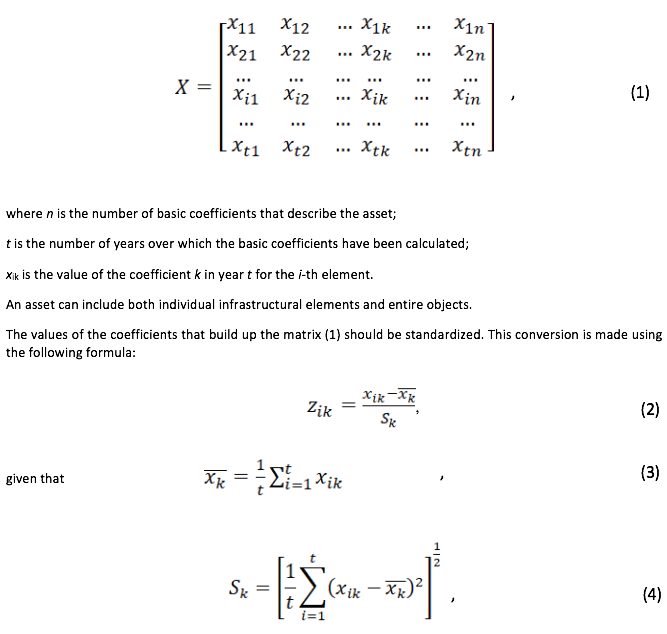

The procedure of attribute standardization not only eliminates units of measurement, but also normalizes the values of these attributes, since the attributes included in the matrix of observations (1) are heterogeneous and describe different qualities of the regional infrastructure.
The next step to be taken in the procedure discussed here is the differentiation of the attributes of the matrix of observations. All variables are broken down into incentives and disincentives. The attributes are divided into these groups based on how each of them, as an infrastructural element, affects the development of territorial innovation clusters.
The attributes that make a positive, stimulating impact on the degree of development of territorial innovation clusters by means of infrastructural elements (in this case, the level and efficiency of the use of resources) are called incentives, unlike the attributes that slow it down and so are called disincentives.
The classification of the attributes into incentives and disincentives provides a basis for building a so-called development baseline which is a point Р0 with the following coordinates:
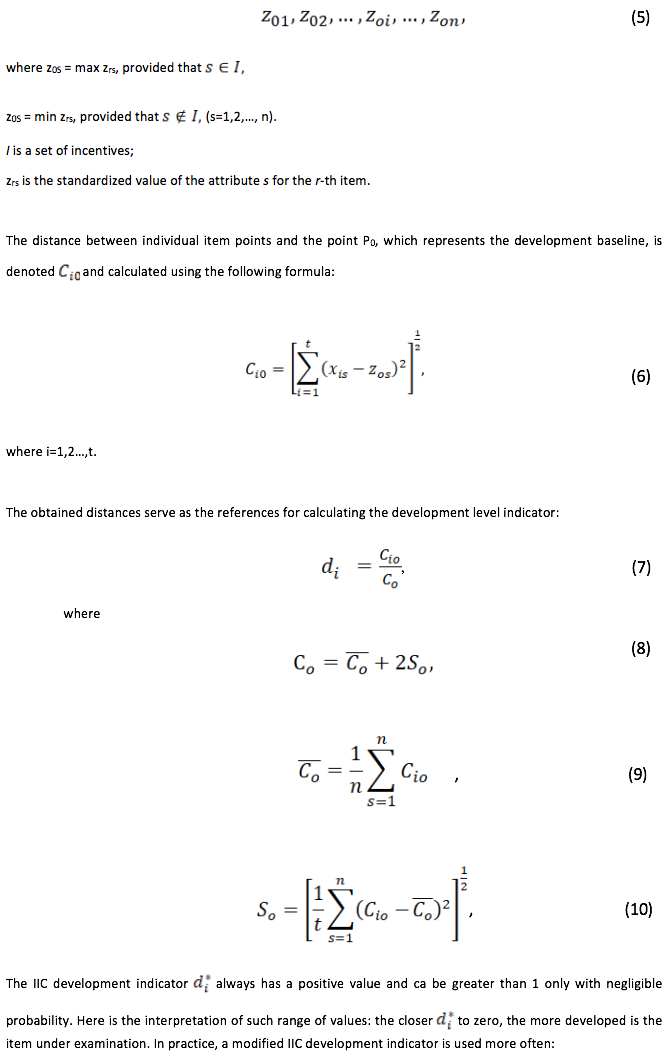
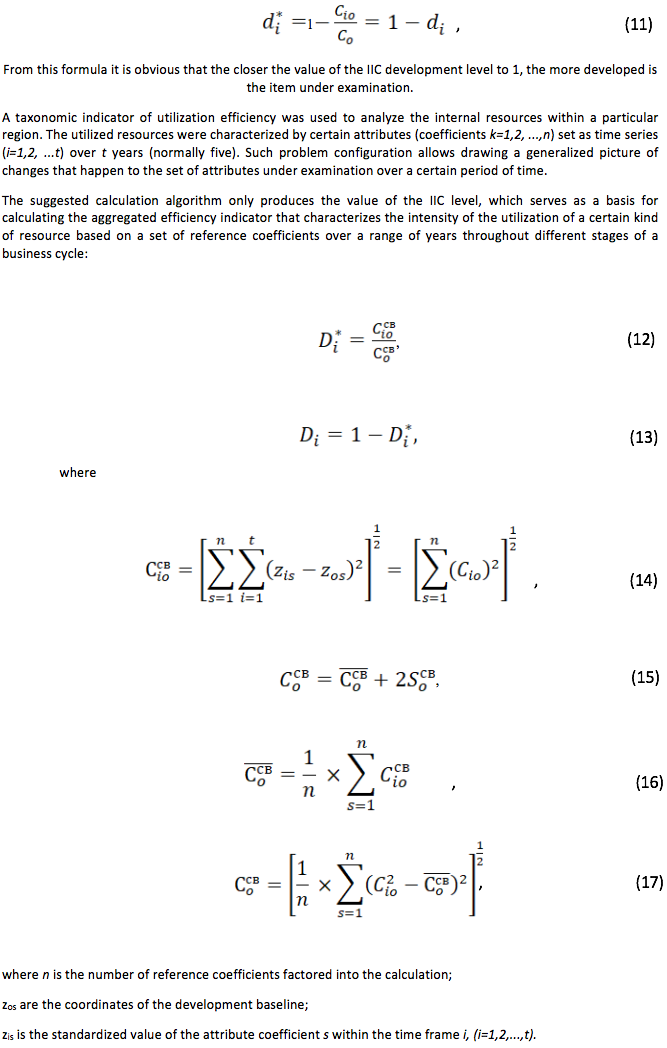
The obtained aggregated utilization efficiency indicator Di reflects the considered process of resource utilization by characterizing the coefficients in question. The value of the indicator reflects the aggregated changes that affected the coefficients over a range of years. This advantage of the method emphasizes the representativeness of the derived quantitative evaluations.
The level of the IIC development is in direct proportion to the efficiency of resource utilization. Therefore, there is a need for a quantitative indicator that characterizes the IIC level in the region and can be computed based on the obtained values for the resource utilization efficiency. It is possible to derive an aggregated indicator by using the elasticity model [1].
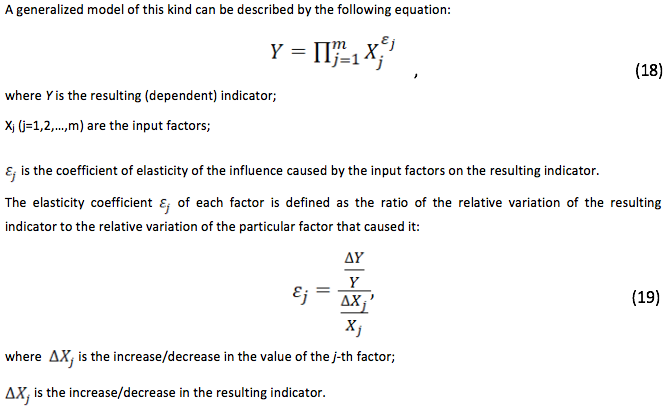
By applying elasticity models, it is possible to account for the influence of a significant number of factors. Elasticity can be defined as the measure of the sensitivity of the dependent variable to one or more independent variables. If the resulting variable depends on numerous independent economic factors with varied elasticity, then it is possible to identify the factors that lead to the most noticeable response from the resulting variable, i.e. the ones whose relative change entails the greatest relative change of the dependent value. This helps reveal the factors that cause the greatest effect on the dependent value.
The absolute value of the elasticity coefficient e characterizes the impact of the corresponding factor on the resulting variable in the following way:
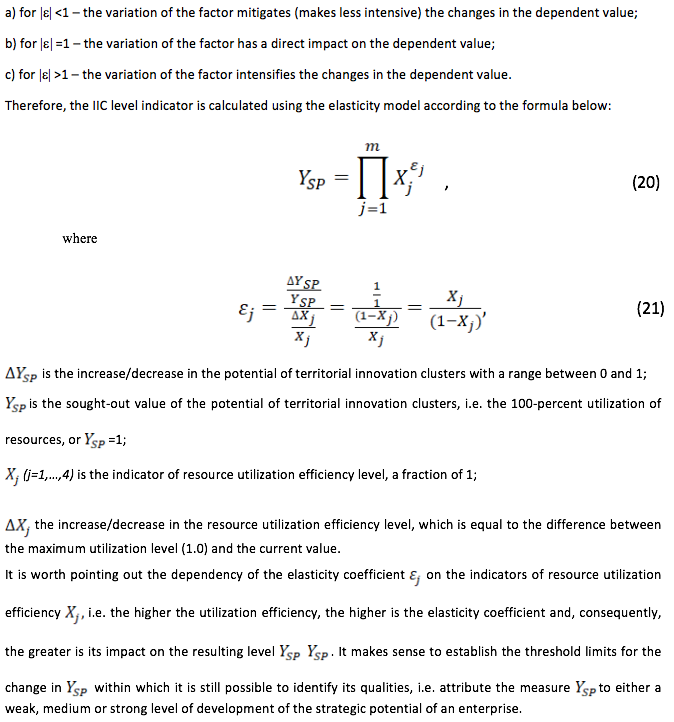
Subsequently, based on taxonomic analysis and using the elasticity model, the authors designed a method of evaluating the efficiency of resource utilization in a given region and of the aggregated IIC level, which allows quantifying both weak and strong points of regional development without the subjective bias of expert assessment.
The designed method has the following benefits:
The subjects of the Russian Federation are highly heterogeneous by their characteristics, starting from population size ending with their economic potential. There is also the difference in how well each regional economy responds to innovations and in the quality of the infrastructure driving economic growth. This difference can be vividly seen between, say, Moscow with its population of over 10 mln people, and the Republic of Mordovia (Privolzhsky Federal District) with the overall population of just 800,000 people of which around 300,000 live in Saransk, the region’s administrative center. This brings up the problem of classifying regions by some common criteria for isolating certain more or less homogeneous groups and identifying the leaders in each of them. In the authors’ opinion, one of such possible criteria is the population size in the regional center. The capital cities are normally the most developed cities in their respected regions, so this indicator, rather than the total number of residents in a region, is the most reasonable one to use as a criterion.
The territory of the Russian Federation is divided into 85 territorial entities – republics, krays, regions, cities of federal importance, an autonomous region and autonomous okrugs. Such a great number of geographical units include 15 cities with over a million residents. They become consolidation points for institutions, research centers, innovative and political powers, company head offices and major production facilities. These are the centers of developed infrastructure that are significantly ahead of the majority of Russia’s other regions by their economic, social and other performance. There are also several cities acting as regional centers, which, although smaller by population, are still quite competitive and enjoy a robust position on Russia’s economic map. Those are such cities as Krasnodar, Tyumen, and Barnaul. Together with million-plus cities, there are around 25 such cities and they are scattered across approximately a third of Russia’s regions.
On this ground, it is possible to categorize all regions into two classes by the number of people living in the respective administrative center of each region. The first class will be comprised of all subjects that are home to more than 600,000 people. The second class will include all other regions. In that case, the first class will only include a third (1/3) of all the country’s region, whereas the second class will include the majority of the subjects (2/3).
Here are the basic indicators by which regions in the Russian Federation are benchmarked:
A – The number of people living in the administrative center;
B – The region’s overall position in the Innovative Development Ranking;
C – Gross regional product (GRP) per each economically active person in the region;
D – The proportion of people employed in high-tech and mid-tech top class industries to the total number of economically active residents of the region;
E – The proportion of people employed in knowledge-based service industries to the total number of economically active residents of the region;
F – The proportion of the people aged 25-64 who have a college degree to the total number of people of that age range;
G – The number of students who are studying for a bachelor’s, specialist’s or master’s degree per every 10,000 residents;
H – Internal spending on research and development as percentage of GRP;
I – The number of publications in peer-reviewed journals cited in the Russian Science Citation Index per every 10 scholars;
J – The number of invention patent applications submitted to Russian Federal Service for Intellectual Property by national applicants per a million economically active people in the region;
K – The proportion of organizations pursuing technical innovations to the total number of organizations (in commercial production);
L – The proportion of small businesses pursuing technical innovations to the total number of small businesses;
M – The volume of spending on technical innovations (in commercial production organizations);
N – The proportion of innovative products, works and services to the total amount of products delivered, works performed and serviced rendered (in commercial production organizations);
O – The proportion of funds from the consolidated budget of the given subject of the Russian Federation which are allocated for financing citizen science to the total amount of spending from the consolidated budget of the subject of the Russian Federation;
P – The proportion of funds from the budget of the given subject of the Russian Federation and local budgets to the total amount of spending on technical innovations;
Q – The ratio of the subsidies allocated from the federal budget on the development of innovation infrastructure for SMB to the total GRP (per RUB 1 mln of GRP);
The average number of residents of administration centers (A) in second-class regions is about 280,000 people, with the maximum count in the Republic of Dagestan (the city of Makhachkala with 580,000 residents) and the minimum count in the Republic of Ingushetia (the town of Magas with 5,000 residents).
The average number is characteristic of Saransk (the Republic of Mordovia), with the population of about 300,000 people. Despite the relatively small area, the republic is one of the leading regions in the Ranking of Innovative Development of the Russian Federation (B), with the average position in this group being 50. The Republic of Mordovia takes the fourth position in this ranking, being inferior only to the Republic of Tatarstan, Moscow and St. Petersburg. This fact makes the republic stand out from the rest of the regions. The republic also tops the ranking by the level of its innovation activity, being well ahead of the Republic of Tatarstan, and stands third in this ranking by the indicator reflecting the quality of innovation policy, being outperformed only by the Republic of Tatarstan and Kaluga Region, which takes the fifth position in the overall ranking and also falls into the second class of regions.
A separate group includes regions where GRP per each economically active resident (C) is greater than RUB 1,000,000. Those are Nenets Autonomous Okrug, Yamalo-Nenets Autonomous Okrug, Khanty-Mansi Autonomous Okrug and Sakhalin Region. In all other regions this figure has a lesser value. The average value of this indicator across the group, inclusive and exclusive of these four regions, is RUB 695,000 and RUB 550,000 respectively. In the Republic of Mordovia this figure is RUB 463,000. This is slightly less than the average, but this indicator, as well as the number of people in the administrative center, allows considering the Republic of Mordovia a typical, representative item of the selected group. For this reason and in line with the purpose of the study, this region specifically was chosen as the most typical, baseline one, which can serve as an example of the current situation and a basis for recommendations for groups of regions with similar economic and social development conditions. The following circumstances reinforce the reasonableness of this approach.
The Republic of Mordovia is in the top ten regions by the parameters listed below:
– the proportion of people employed in high-tech and mid-tech top class industries to the total number of economically active residents of the region (D);
– the proportion of the people aged 25-64 who have a college degree to the total number of people of that age range (F);
– the number of students who are studying for a bachelor’s, specialist’s or master’s degree per every 10,000 residents (G).
In addition to that, its average scores across a group of indicators are significantly higher than the scores of other regions.
At the same time, it has a lower value of the parameter the proportion of people employed in knowledge-based service industries to the total number of economically active residents of the region, which can be attributed to the fact that the region’s economy is largely focused on the production of high-tech products rather than knowledge-based services.
Two more indicators can be considered in this category, the number of publications in peer-reviewed journals cited in the Russian Science Citation Index per every 10 scholars (I) and the number of invention patent applications submitted to Russian Federal Service for Intellectual Property by national applicants per a million economically active people in the region (J). Interestingly, the region is also in the top ten by the number of scientific publications. As for the number of patent applications, the region is somewhat behind the group’s average number, with 140 applications vs. the average of 186. Apparently, the deviation from the average is not that material.
It should be pointed out that of all the regions in the considered group, only 7 subjects have a higher education facility that has one of the following statuses: National Research University, Federal University or part of the 5-100 University Project. The Republic of Mordovia is home to N. Ogarev Mordovian State National Research University. This secures the region its leadership in many aspects considered in this category.
The republic is also among the three subjects that host a high-technology park, which gives it leadership in other parameters of this category.
The last parameter by which Mordovia falls behind the group’s average value is The proportion of funds from the budget of the given subject of the Russian Federation and local budgets to the total amount of spending on technical innovations (Р). In this case, the lag is a positive sign, as it shows that to secure a competitive edge against other regions, it does not necessarily takes pouring a large amount of internal funds (if any available) and that given a well-thought-out innovation strategy in the region, it is possible to provide financing from federal budget or private investors.
Another indicator which is close to the group’s average is the Internal spending on research and development as percentage of GRP (H). The average being 0.55%, in the Republic Mordovia it is 0.61% of the internal spending. It means that despite having an average internal R&D budget, the region can still have a good growth dynamic and enjoy lots of other competitive strengths.
In all other indicators, the scores of the Republic of Mordovia are higher than the averages in the selected group of regions and higher than the scores of most of those regions. It is in the top five by the following indicators:
– The proportion of organizations pursuing technical innovations to the total number of organizations (in commercial production) (K);
– The proportion of small businesses pursuing technical innovations to the total number of small businesses (L);
– The volume of spending on technical innovations (in commercial production organizations) (M);
– The proportion of innovative products, works and services to the total amount of products delivered, works performed and serviced rendered (in commercial production organizations) (N);
– The proportion of funds from the consolidated budget of the given subject of the Russian Federation which are allocated for financing citizen science to the total amount of spending from the consolidated budget of the subject of the Russian Federation; (O);
– The ratio of the subsidies allocated from the federal budget on the development of innovation infrastructure for SMB to the total GRP (per RUB 1 mln of GRP) (Q).
Amidst all analyzed regions, only six have a special economic zone for industrial or technology implementation needs. Mordovia is not one of them. This tells us that special economic zones are not necessarily the prerequisites for the leadership in innovation, especially in commercial production. This conclusion becomes even more pertinent if you consider that only around 10% of regions actually have such infrastructural platforms. About 9% of regions, specifically five, have within their boundaries a cluster from the List of Experimental Innovation Territorial Clusters. These regions include Tomsk, Kemerovo, Kaluga and Moscow Regions and the Republic of Mordovia.
Thirty-six regions, or approximately 65% of the group, have a specialized coordination body for innovation policy attached to a high-profile official or a higher body of public executive power of the respective subject of the Russian Federation. Twelve regions, or approximately 22% of the group, have a specialized institute for development in charge of supporting innovation agents and/or implementing innovative projects. The Republic of Mordovia fits in with both these characteristics.
On top of that, it is worth highlighting the region’s achievements by individual components of the Innovation Ranking. By such parameters as the innovative activity of organizations, small innovative business, spending on and performance of innovative activities, Mordovia scores much higher than the average results across other regions. The quality of its innovation policy is also quite high, especially from the organizational perspective. The results achieved in the region’s innovation efforts can set the example of best practices which eventually, provided that the state offers its best support, can lead the way of growth for other, less successful regions.
This article is the first in a series of articles written by the authors in a bid to identify the areas for advancing the project-based infrastructural interaction between the members of territorial innovation clusters. The next articles will offer the synthesis of the designed method for establishing the level of impact of infrastructural elements on the development of territorial innovation clusters with the parameters from the 17 indicators presented in the Results section.
In this article, the authors have made a retrospective analysis of the scholarly papers written by the scholars who specialize in the development of territorial innovation clusters in the context of the existing infrastructure. The study offers the method of assessing how the infrastructure elements affect the development of territorial innovation clusters.
The designed method has the following benefits:
The authors distinguish 17 basic indicators that are currently used by public authorities to benchmark the regions of the Russian Federation. Those can be set as the basic indicators for calculating the degree of development of territorial innovation clusters based on the method suggested by the authors.
This article is the first in a series of articles written by the authors in a bid to identify the areas for advancing the project-based infrastructural interaction between the members of territorial innovation clusters. The next articles will offer the synthesis of the designed method for establishing the level of impact of infrastructural elements on the development of territorial innovation clusters with the parameters from the 17 basic indicators that are currently used by public authorities to benchmark the regions of the Russian Federation.
This article has been prepared with the support of the Russian Foundation for Basic Research (RFBR), grant #17-02-00390-OGH "The project-based approach to the development of strategic potential of territorial innovation clusters” OGH-A – RHSF Primary competition 2017.
Belussi, F., Sammarra, A. (2009). Business networks in clusters and industrial districts: The governance of the global value chain, 1-413. London-New York: Routledge.
Biggiero, L. (2006). Industrial and knowledge relocation strategies under the challenges of globalization and digitalization: The move of small and medium enterprises among territorial systems. Entrepreneurship and Regional Development, 18(6), 443-471. DOI: 10.1080/08985620600884701
Cappellin, R. (2003). Territorial knowledge management: Towards a metrics of the cognitive dimension of agglomeration economies. International Journal of Technology Management, 26(2-4), 303-325.
Cheshire, P.C., Malecki, E.J. (2003). Growth, development, and innovation: A look backward and forward. Papers in Regional Science, 83(1), 249-267.
Cooke, P. (2001). Regional innovation systems, clusters and the knowledge economy. Industrial and Corporate Change, 10(4), 945–971.
Cumbers, A., Leibovitz, J., MacKinnon, D. (2007). Institutional features, path dependencies and regional industrial change: Comparing mature and embryonic clusters in an old industrial region. International Journal of Entrepreneurship and Innovation Management, 7(2-5), 424-444.
Doloreux, D. (2004). Regional networks of small and medium sized enterprises: Evidence from the metropolitan area of Ottawa in Canada. European Planning Studies, 12(2), 173-190.
Gafurov, I.R., Platonova, O.U., Pratchenko, O.V. (2014). New state economic policy - Cluster policy cluster policy as the factor of innovative development of Europe. Mediterranean Journal of Social Sciences, 5(12), 107-111.
Gryzunova, N.V., Tsertseil, J.S., Kookueva, V.V., Zaharova, Dg.S. (2018). Monetary policy and clustering for achieving competitiveness in national business. European Research Studies Journal, 21(1): 480-490.
Gureva, M.A., Lyubimtseva, S.V., Tukhkanen, T.N., Simonova, L.M., Kolpak, E.P. (2016). Functioning of innovative territorial clusters. International Journal of Economics and Financial Issues, 6 (8 Special Issue), 115-120.
Huber, F. (2012). Do clusters really matter for innovation practices in information technology? Questioning the significance of technological knowledge spillovers. Journal of Economic Geography, 12(1), lbq 058, 107-126.
Kutsenko, E. (2015). Pilot innovative territorial clusters in Russia: A sustainable development model. Foresight Russia, 9(1), 32-55.
Lundvall, B.A. (1992). National Systems of Innovation: Towards a Theory of Innovation and Interactive Learning, London: Pinter
MacNeill, S., and Steiner, M. (2010). Leadership of cluster policy: Lessons from the Austrian province of Styria. Policy Studies, 31(4), 441-455.
Matkovskaya, Y.S. (2017). Clusters: Sense of market approach to their formation and substantiation of necessity for development of mathematical apparatus for modeling of their development. Journal of Applied Economic Sciences, 12(2), 572-582.
Molina-Morales, F.X., García-Villaverde, P.M., Parra-Requena, G. (2014). Geographical and cognitive proximity effects on innovation performance in SMEs: A way through knowledge acquisition. International Entrepreneurship and Management Journal, 10(2), 231-251.
Monni, S., Palumbo, F., Tvaronavičienė, M. (2017). Cluster performance: an attempt to evaluate the Lithuanian case. Entrepreneurship and Sustainability Issues, 5(1), 43-57.
Montresor, S., and Marzetti, G.V. (2008). Innovation clusters in technological systems: A network analysis of 15 OECD countries for the mid-1990s. Industry and Innovation, 15(3), 321-346.
Parrilli, M.D., Aranguren, M.J., Larrea, M. (2010). The role of interactive learning to close the "innovation gap" in SME-based local economies: A furniture cluster in the Basque country and its key policy implications. European Planning Studies, 18(3), 351-370.
Smith, H.L. (2007). Universities, innovation, and territorial development: A review of the evidence. Environment and Planning C: Government and Policy, 25(1), 98-114.
Taranova, I.V., Gunko, A.Y., Alekseeva, O.A., Bunchikov, O.N., Kurennaya, V.V. (2015). Development of methodical approach on identification of cluster forms of the organization of economy of the traditional and agrarian region. Asian Social Science, 11(14), 95-103.
Walter, T., and Werner, R. (2001). Regional innovation systems: The territorial dimension of knowledge and innovation (German language). Zeitschrift fur Wirtschaftsgeographie, 45(3-4), 202-218.
1. Doctor of Sciences (Economics), Professor, Department of Management, National Research Mordovia State University, Saransk, Russian Federation
2. Minister of Information Technology and Communications of the Republic of Mordovia, Candidate of Sciences (Economics), Associate Professor, Department of Management, National Research Mordovia State University, Saransk, Russian Federation
3. Candidate of Sciences (Economics), Associate Professor, Department of Management, National Research Mordovia State University, Saransk, Russian Federation. Contact e-mail: gorivan77@mail.ru